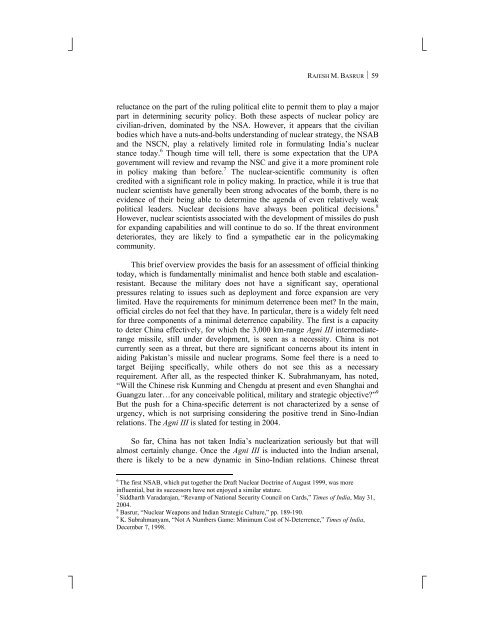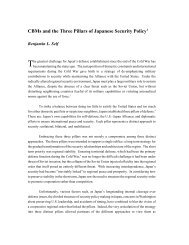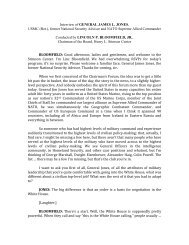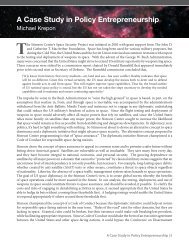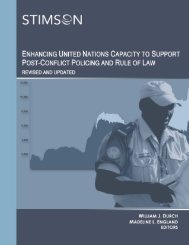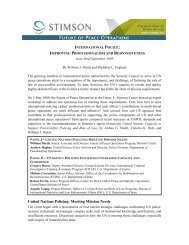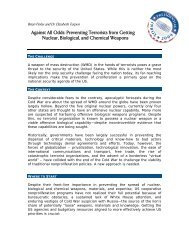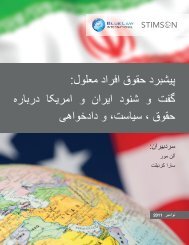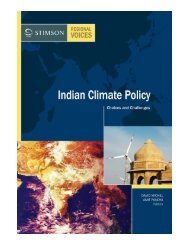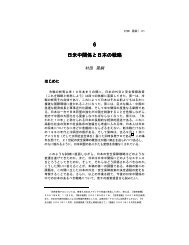India's Escalation-Resistant Nuclear Posture - The Stimson Center
India's Escalation-Resistant Nuclear Posture - The Stimson Center
India's Escalation-Resistant Nuclear Posture - The Stimson Center
Create successful ePaper yourself
Turn your PDF publications into a flip-book with our unique Google optimized e-Paper software.
⎦<br />
⎣<br />
RAJESH M. BASRUR ⏐ 59<br />
reluctance on the part of the ruling political elite to permit them to play a major<br />
part in determining security policy. Both these aspects of nuclear policy are<br />
civilian-driven, dominated by the NSA. However, it appears that the civilian<br />
bodies which have a nuts-and-bolts understanding of nuclear strategy, the NSAB<br />
and the NSCN, play a relatively limited role in formulating India’s nuclear<br />
stance today. 6 Though time will tell, there is some expectation that the UPA<br />
government will review and revamp the NSC and give it a more prominent role<br />
in policy making than before. 7 <strong>The</strong> nuclear-scientific community is often<br />
credited with a significant role in policy making. In practice, while it is true that<br />
nuclear scientists have generally been strong advocates of the bomb, there is no<br />
evidence of their being able to determine the agenda of even relatively weak<br />
political leaders. <strong>Nuclear</strong> decisions have always been political decisions. 8<br />
However, nuclear scientists associated with the development of missiles do push<br />
for expanding capabilities and will continue to do so. If the threat environment<br />
deteriorates, they are likely to find a sympathetic ear in the policymaking<br />
community.<br />
This brief overview provides the basis for an assessment of official thinking<br />
today, which is fundamentally minimalist and hence both stable and escalationresistant.<br />
Because the military does not have a significant say, operational<br />
pressures relating to issues such as deployment and force expansion are very<br />
limited. Have the requirements for minimum deterrence been met? In the main,<br />
official circles do not feel that they have. In particular, there is a widely felt need<br />
for three components of a minimal deterrence capability. <strong>The</strong> first is a capacity<br />
to deter China effectively, for which the 3,000 km-range Agni III intermediaterange<br />
missile, still under development, is seen as a necessity. China is not<br />
currently seen as a threat, but there are significant concerns about its intent in<br />
aiding Pakistan’s missile and nuclear programs. Some feel there is a need to<br />
target Beijing specifically, while others do not see this as a necessary<br />
requirement. After all, as the respected thinker K. Subrahmanyam, has noted,<br />
“Will the Chinese risk Kunming and Chengdu at present and even Shanghai and<br />
Guangzu later…for any conceivable political, military and strategic objective?” 9<br />
But the push for a China-specific deterrent is not characterized by a sense of<br />
urgency, which is not surprising considering the positive trend in Sino-Indian<br />
relations. <strong>The</strong> Agni III is slated for testing in 2004.<br />
So far, China has not taken India’s nuclearization seriously but that will<br />
almost certainly change. Once the Agni III is inducted into the Indian arsenal,<br />
there is likely to be a new dynamic in Sino-Indian relations. Chinese threat<br />
6<br />
<strong>The</strong> first NSAB, which put together the Draft <strong>Nuclear</strong> Doctrine of August 1999, was more<br />
influential, but its successors have not enjoyed a similar stature.<br />
7<br />
Siddharth Varadarajan, “Revamp of National Security Council on Cards,” Times of India, May 31,<br />
2004.<br />
8 Basrur, “<strong>Nuclear</strong> Weapons and Indian Strategic Culture,” pp. 189-190.<br />
9 K. Subrahmanyam, “Not A Numbers Game: Minimum Cost of N-Deterrence,” Times of India,<br />
December 7, 1998.<br />
⎤<br />
⎡


